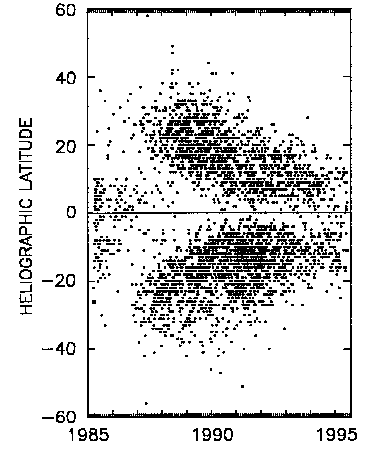Butterflies and New Solar Cycles
The butterfly diagram below shows the solar latitude of Cycle 22 sunspot groups observed between 1985 and 1995 - Cycle 22 extended from September 1986 to May 1996. In both northern and southern hemispheres, the location of sunspot groups shows a steady drift from higher latitudes early in the solar cycle towards lower, more equatorial latitudes at the end of the cycle. The combination of northern and southern hemisphere data in the diagram produces the look of the wings of a butterfly and hence its name.

At the left during 1985-86, there is a cluster of points at low latitudes belonging to the end of the butterfly wings for the previous Cycle 21. During this period both cycles co-existed, with the higher latitude regions "belonging" to Cycle 22 and the equatorial ones to Cycle 21.
Latitude is a good indicator of whether a sunspot group belongs to the "old" cycle or to the "new" cycle. Around the time of solar minimum old cycle regions are appearing at solar latitudes of 5-15 degrees north and south of the equator. The first new cycle regions typically appear at latitudes of 20-30 degrees from the equator. Latitude is not the only indicator because detailed analysis of magnetic fields within the regions can confirm to which cycle they belong.
Solar regions in a hemisphere have a characteristic magnetic structure where the leading spots (i.e. most westward) in the group have magnetic field directed into or out of the Sun's surface and the trailing spots in the group have magnetic field opposed to the leader spots. The situation is reversed in the other hemisphere. For example, if the magnetic field is directed out of the Sun's surface in the leader spots in the northern hemisphere, the magnetic field of southern hemisphere trailing spots will also be directed outwards while northern hemisphere trailing spots and southern hemisphere leader spots will have magnetic field directed into the Sun.
On rare occasions however, solar regions from one hemisphere can migrate to the other hemisphere seeming to appear as new cycle regions. In May 1995 a reverse polarity region appeared at the low latitude of 13 degrees north. At that stage, it was unsure as to whether the region had migrated across the equator. However, when further reverse polarity regions occurred in July and August 1995, it was considered the group had been a new cycle region.
The arrival (or non-arrival) of new cycle sunspots can tell us about when a solar cycle will end - called solar minimum. The table below shows the number of months prior to solar minimum of the first new cycle regions.
| Cycle | Cycle End | Occurrence of First New Cycle Region |
|---|---|---|
| 20 | June 1976 | February 1975 (16 months) |
| 21 | September 1986 | April 1985 (17 months) |
| 22 | May 1996 | May 1995 (12 months) |
| 23 | December 2008 | December 2007 (12 months) |
Material prepared by Richard Thompson. Our thanks to Peter Taylor (American Sunspot Number Program) for the diagram based on sunspot locations from Space Environment Services Center in Boulder, USA.





